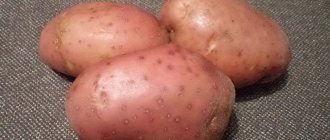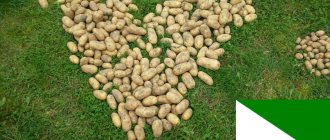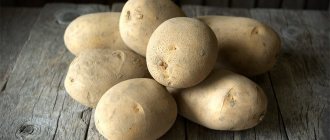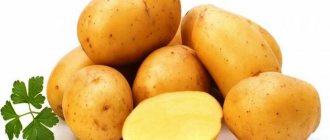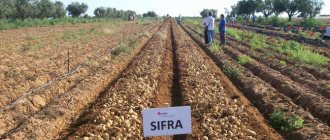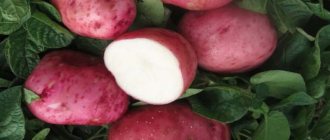Description of the variety
The Santana potato was developed by German and Dutch breeders. In Russia it was added to the register in 2006.
In addition to starch (13.4-17.3%), Santana contains a balanced complex of amino acids, vitamins B, C, H and PP, folic acid, as well as useful minerals: potassium, calcium, magnesium, zinc, selenium, copper and manganese, iron, chlorine and sulfur, iodine, chromium, fluorine, molybdenum, boron and vanadium, tin and titanium, silicon, cobalt, nickel and aluminum, phosphorus and sodium.
Santana is rich in fiber, but its difference is that in tubers the fiber is soft and does not irritate the walls of the digestive tract.
Santana potatoes are considered mid-season - its tubers can be harvested 80-95 days after planting.
Reference . The yield of Santana depends on planting and care conditions and reaches 419 c/ha. The average yield varies between 164-384 c/ha.
Plants are resistant to golden cyst nematode, viral diseases and potato cancer. But there is a high susceptibility to late blight of tubers and tops when grown in field conditions.
Santana tubers are smooth, reach large sizes, have the shape of a long oval, are strewn with small superficial eyes and are covered with a smooth, light yellow skin. The pulp of potatoes of this variety is white-yellow.
The plant is medium-sized, semi-erect, with large, dark green, wavy leaves. The flowers are red-violet in color. The Santana variety is unpretentious and does not require special growing conditions. Areas for cultivating this potato: Northwestern, Central and Central Black Earth regions. The plant exhibits best productivity when planted in light, sandy soil.
Potatoes "Santana": description of the variety
| Variety name | Santana |
| general characteristics | mid-season table potato variety of Dutch selection, sensitive to lack of moisture |
| Maturation period | 80-95 days |
| Starch content | 13-17% |
| Weight of marketable tubers | 90-170 gr |
| Number of tubers in a bush | 6-11 |
| Productivity | 164-384 (maximum – 419) c/ha |
| Consumer qualities | excellent taste, suitable for salads, frying, making French fries and chips |
| Keeping quality | 92% |
| Peel color | yellow |
| Flesh color | white |
| Preferred Growing Regions | Northwestern, Central, Central Black Earth |
| Disease resistance | the variety is resistant to golden nematode, viruses and potato cancer |
| Features of cultivation | standard agricultural technology |
| Originator | Handelmaatschappij Van Rijn BV (Holland) |
Potatoes "Santana" are considered a mid-season variety. The period from the appearance of the first shoots to full ripening ranges from 80 to 95 days. The tubers are distinguished by their oval shape and smooth, yellow skin. The main feature of the appearance is the numerous small “eyes” across the entire surface of the tuber.
The potato pulp is light yellow. The average weight of tubers is 90-120 g . But sometimes there may be specimens whose weight reaches 170 grams.
The variety is medium starchy. As a rule, the content of starchy substances in a tuber does not exceed 13–17%. Thanks to this quality, heat treatment eliminates the possibility of cracking and overcooking of potatoes.
In the table below you can find the main characteristics of other potato varieties:
| Variety name | Starch content | Keeping quality |
| Santana | 13-17% | 92% |
| Milena | 11-14% | 95% |
| Elmundo | 12-14% | 97% |
| Sheri | 11-15% | 91% |
| Bryansk delicacy | 16-18% | 94% |
| Ariel | 13-16% | 94% |
| Borovichok | 13-17% | 94% |
| Tuscany | 12-14% | 93% |
Despite the average starch content, the taste of potatoes remains high . "Santana" is considered an ideal variety for making chips and French fries. The tubers retain their appetizing appearance when fried, as well as in various types of salads. The product can be used for making purees.
Advantages and disadvantages
Santana potatoes are varieties that have a minimum of disadvantages:
- high susceptibility to late blight;
- poor tolerance to drought;
- instability to mechanical damage.
But this variety boasts a number of advantages:
- resistance to viruses, cancer and nematodes;
- unpretentiousness;
- good keeping quality – up to 9 months;
- high productivity;
- excellent taste;
- up to 99% marketability;
- large smooth tubers.
The main advantages and disadvantages of the variety
The undoubted advantages of the Santana variety include:
- undemanding when providing care;
- good shelf life - potatoes can be stored until next spring without much loss;
- stable immunity to some diseases and pests (viral diseases, cancer, golden nematode);
- consistently high yields;
- excellent taste;
- presentable presentation - most of the tubers are large and even.
The variety, of course, also has disadvantages, but compared to the positive characteristics, there are few of them:
- poor ability of the variety to tolerate drought conditions;
- low resistance of tubers to mechanical damage;
- poor immunity to late blight.
Features of planting and growing
The Santana variety does not require special skills when planting and growing, but several rules should be followed:
- It is better to plant seed material in areas where legumes, grain plants or perennial grasses previously grew.
- 30 days before planting, the planting tubers are transferred to a warm place with good lighting. These conditions are favorable for seed germination. Tubers germinate best in boxes with damp sawdust.
- The harvest will be richer if, after germination, the tubers are pickled and treated with growth activators.
- A favorable time for planting seeds is the beginning of May. The soil at a depth of 10 cm should be heated to +8°C. If this temperature has not yet been reached, it is better to postpone planting potatoes.
- When planting, maintain a distance between holes of 300-350 mm, and between rows - 600-700 mm.
- If the soil is heavy, planting tubers are buried 80 mm. Plant in light soil to a depth of 100 mm.
- To achieve high yields, a high furrow is formed.
Be sure to carry out early loosening, but not deeper than 3 cm. This improves oxygen access to the tubers and helps get rid of small weeds.
They also loosen the soil after rains - moisture quickly evaporates through cracks in the crust, and this prevents loosening. Loosen the ground so as not to damage the sprouts and not pull the tubers to the surface.
Article on the topic: Potato variety “Governor” - description and photo
Hilling and weeding
Hilling is one of the measures to prevent late blight of tubers. The first hilling is carried out on moist soil, when the tops have not yet grown above 12-15 cm.
The soil is raked up to the tops with a hoe or flat cutter, forming a small mound around the bush. The procedure protects the plant from possible frosts. The second hilling is carried out 1.5-2 weeks after the first to accelerate tuber formation.
As the weeds become overgrown, the rows are weeded.
Plants need the most water during tuberization. This period begins with the appearance of buds and flowering. At this time, in the absence of rain, additional watering is provided to maintain soil moisture at least 80-85%.
Three feedings are done during the season:
- During the growth of tops, if there is weak development of potato bushes - the leaves are pale, the stems are thin. The bushes are watered with a solution: 10 liters of water, 1 tsp. urea and 1 tbsp. l. "Effekton" fertilizers for vegetables. One bush requires 0.5 liters of ready-made solution. It is better to feed in damp soil - after rain or watering.
- During the appearance of buds: 10 liters of water, 1 glass of wood ash and 1 tbsp. l. potassium sulfate. This solution activates flowering.
- The purpose of the third feeding is to accelerate the formation of tubers. It is made during the flowering period of the bushes: 10 liters of water, 1 tbsp. l. "Effekton" and 1 tbsp. l. superphosphate. Use 0.5 liters of the prepared solution per bush.
The row spacing is mulched with mowed grass or straw.
Diseases and pests
The fact that plants are affected by late blight is indicated by a dark coating on the leaves. This is the main sign of the disease. Over time, a white coating appears on the back of the leaf blades. Most often, potatoes are affected by late blight in July, but cases of the disease are reported in May and June.
Fighting late blight:
- To strengthen the immune system, infected potatoes are sprayed with Epin. This product is a biostimulant with an anti-stress effect. It is produced in the form of ampoules of 0.3 ml. 2 hours before treatment, one ampoule is diluted in 5 liters of water. While the solution is infused, the bushes are inspected and dried leaves and stems are removed. 100 ml of solution is used for each bush.
- An effective remedy against late blight is the drug “HOM”. The product is used strictly after flowering. While processing the bushes, protect the skin and mucous membranes from contact with the drug by wearing gloves, respirators, masks, and goggles. The working solution is prepared as follows: 40 g of the product is dissolved in 10 liters of water, the liquid is mixed and another 2-4 liters of water are poured into it. The potato field is sprayed with this solution. 1 liter of working fluid is consumed per 10 m2.
- Sometimes the fight against potato late blight is carried out using Trichopolum tablets. They treat plants before or after flowering. Dissolve 15-20 Trichopolum tablets in 10 liters of water and spray the potato bushes in sunny, dry weather.
To prevent late blight, plants are sprayed with products containing copper: “Idol”, “Metaxil”, “Ordan”, “Raek”, “Talent”.
To combat insect pests, the green part of plants is treated with industrial insecticides: “Borey”, “Borey Neo”, “Shar Pei”, “Sirocco”, “Tanrek”.
Difficulties in growing
The Santana variety is considered easy to care for, but difficulties may arise when grown during drought or late blight epidemics. Potatoes will require abundant and frequent watering and the use of special products: “Idol”, “Metaxil”, “Ordan”, “Raek”, “Talent”.
Harvest and storage
Harvest as soon as the tops turn yellow and fall to the ground. A week before harvesting potatoes, the green part of the plants is mowed down. It is better to harvest on a sunny, warm day - this way the tubers will dry out faster.
Before harvesting for storage, potatoes are air dried, but not left in the sun for more than a few hours, otherwise they will begin to turn green.
Attention! Rotten, damaged or green tubers are not suitable for long-term storage - they need to be sorted.
In the room where tubers are planned to be stored, favorable conditions are created: ventilation, temperature +2...+4°C and humidity 80%. At low temperatures the vegetable will freeze and become sweet, and at high temperatures it will germinate.
Tubers of the Santana variety are able to retain their taste and nutritional value for 6-9 months.
Related article: Potato variety “Ariel” - description and photo
There are a number of potato diseases that can affect the vegetable during storage - ring rot, dry rot, scab, wet rot.
To avoid mass damage, tubers are regularly inspected and those that show signs of disease are thrown away.
Tips and reviews from experienced gardeners about the Santana variety
Experienced gardeners note the positive characteristics of the variety and the problems they encounter during cultivation.
Elena, Chelyabinsk: “ I decided to plant potatoes with seeds in order to plant the elite next year. They say that the potatoes we plant for several years in a row degenerate. Therefore, once every 5-6 years it is worth planting potatoes with seeds. And then neither the Colorado potato beetle nor late blight will affect him. I plant later than my neighbors. Be sure to put a little compost in the hole, then potatoes with sprouts down and cover with soil. My soil is clayey, very loose. Another plus of flagstone is pebbles. When it is hot during the day, they heat up, giving off coolness, and on a cold night, they give off heat. This year's potato harvest - we dug up 70 from 8 buckets. Well, we didn't collect small change, there were about two buckets left. But what’s not very good is that there is a problem with wireworms.”
Nelli, Torzhok: “The taste of Santana potatoes is excellent. All dishes with it have a pleasant taste, the tubers are even, without deep eyes. If I get late blight, Siyanie-2 helps me. I make a mash with it and soak the tubers for 1-2 hours before planting. When the potatoes hatch, I almost immediately mulch with cut grass. The main thing is that it is without seeds. Mulch is our salvation! The disadvantage of this variety is that for some reason some of the tubers in my cellar quickly wither.”
Santana is a variety of Potato plant
Variety characteristics:
Properties of the Santana variety:
Recommended region on the map:
Information on the admission of Santana Potatoes from the Register of the State Variety Commission of the Russian Federation
Application for admission No. 39879, registered 2003-04-28. Potato variety Santana was included in the register of approved varieties in 2006. Approved for use in the regions: North-Western, Central, Central Black Earth.
The originator of the Potato Santana variety is:
- STET HOLLAND BV (PRODUKTIEWEG 2A, 8304 AV EMMELOORD, THE NETHERLANDS)
Other plant varieties Potato
Variety selection
Question to the expert
If you haven't found the answer to a question, don't hesitate to ask an expert.
Add new comment
Register or Login so you don't have to enter your Name and Email every time
Thanks for the comment! It will be published after checking by a moderator!
Comments
No comments yet, be the first!
A portal for those who love their dacha
Thanks for your question!
Your question has been sent for moderation. Don't worry, we quickly check your questions and your question will be answered within 1 day.
We have noticed that you are already registered on our website. We recommend that you log in to view the question you created. If you don't remember your password, you can recover it.
You were not registered until today, so we have registered you. Your password has been sent to your specified mailbox.
Help our site develop!
Please read this message, it will not take up much of your time!
We so need your comments and questions to understand in which direction we should develop.
Don't forget to leave a comment if you found what you were looking for. And if you haven’t found it, use the “Ask an Expert” form in the site header. We will answer this question, and other visitors will be able to find the information that you could not find.
Sincerely, team of the portal Dacha-Dacha.ru
Thanks for your question!
Your question has been sent for moderation. Don't worry, we quickly check your questions and your question will be answered within 1 day.
We have noticed that you are already registered on our website. We recommend that you log in to view the question you created. If you don't remember your password, you can recover it.
Article on the topic: Potato variety “Madam” - description and photo
You were not registered until today, so we have registered you. Your password has been sent to your specified mailbox.
Potato variety "Santana": characteristics, yield, reviews and photos
Choosing a high-quality potato variety for your personal plot is not so easy. Today there are a huge variety of potato varieties, so it is quite difficult to choose the right one. By experimenting with several varieties, you can select the most suitable variety with excellent taste characteristics. Many gardeners prefer the Santana variety, which has good external characteristics, taste and high yield.
Growing potatoes from A to Z:
Description of the variety
Roots:
- The tubers are oval in shape;
- Smooth yellow peel;
- Small numerous eyes;
- The pulp is light yellow when cut;
- Starch content from 13 to 17%;
- The average weight varies from 90 to 120 grams;
- Each bush produces a harvest of 6-11 root crops.
Bushes:
- The plant is low, semi-erect, intermediate type;
- Large dark green leaves with slight wavy edges;
- Inflorescences are red-violet.
Growing potatoes using Gordeev technology:
Potato Galaxy: variety description
The erect plant reaches a height of approximately 120 cm. The powerful stems have slight ribbing and a smooth green surface. The bush produces branches up to 30 cm long. The size of the pinnately dissected leaves is large, the color is dark green. The flowers are purple in color with a yellow center.
Origin and development
The Galaxy potato variety is relatively new on the domestic market. The root crop was bred by Irish breeders
Initially, experts planned to obtain an early ripening variety that would be invulnerable to late blight, but additionally paid attention to taste and shelf life. The crop passed all varietal tests and was included in the State Register of the Russian Federation in 2008
Chemical composition, trace elements and vitamins
Potatoes contain a large amount of starch - approximately 15-18%. The concentration of this substance directly depends on the nutritional value of the soil in which vegetables are grown. On well-fertilized soils, the level of starch will be higher.
The Galaxy potato is a dietary variety. Per 100 g of product, the calorie content is no more than 80 kcal. Also, the tubers contain a significant amount of organic acids, vitamins, carotenoids, macro- and microelements. The fat concentration per 100 g is only 0.6%.
Ripening period
Potato Galaxy is an early variety. Root crops fully ripen 90 days after planting. Irish potatoes have excellent taste, stable yields and strong immunity to pests and most fungal diseases.
Productivity
The tubers themselves are medium in size. The standard weight of one potato is 90 g. Up to 13-14 root crops ripen in a hole. With good care, vegetable growers harvest up to 300 centners of potatoes from 1 hectare of planting (an average of 250 centners).
Disease resistance
Diseases to which the Galaxy variety is immune:
- Alternaria blight. A characteristic sign of infection is the appearance of dark brown or brown spots on the leaves, which are clearly visible 2-3 weeks before flowering. With a high degree of damage, the foliage turns yellow and falls off.
- Late blight. A diseased bush is distinguished from a healthy one by tiny but rapidly increasing brown spots on the leaves, which gradually spread to the stem itself. In dry weather, the infected plant dries out; in rainy weather, it begins to rot.
- Potato cancer. This is a fungal disease that affects tubers, stems, and leaves. They become covered with warty growths, and the root vegetables become unsuitable for consumption and quickly deteriorate and rot.
- Rhizoctoniosis. The most common sign of the disease is deepened dark spots, as well as reticular necrosis. The roots of the potato gradually rot, and the leaves of the plant fall off. With high humidity and in loamy soil, parasitic bacteria develop much faster.
Characteristics of tubers, description of appearance
The shape of the potato is round-oval. The smooth tubers are creamy in color with a few pink eyes and small brown dots. The pulp has a yellow tint and crumbles when cooked.
For which regions is it best suited?
Galaxy potatoes are suitable for growing in various climatic conditions. Recommended for cultivation in the North-Western, Central and Volga-Vyatka regions, but it is successfully grown throughout almost the entire territory of Russia, Belarus and Ukraine.
Advantages, disadvantages and taste
Santana potatoes have the following benefits:
- Undemanding in cultivation and care;
- Ability for long-term storage;
- Excellent taste characteristics of root vegetables;
- High yield.
The disadvantages of the Santana variety include:
- Poor tolerance to dry periods;
- Instability to mechanical damage.
Description and characteristics of the variety
In terms of timing, Santana Elite potatoes are mid-season, ripening 80-95 days after germination. The plant is small or medium-sized, intermediate type, semi-erect. The bush is covered with large dark green leaves with slightly to medium wavy edges. Inflorescences of a red-purple hue. From a bush you get 6-11 root crops.
- weight 96-168 g;
- oval-oblong shape;
- the eyes are very small, it is convenient to peel the fruits;
- skin without mesh, yellow;
- the flesh is creamy or white;
- starch in fruits 13.4-17.3%;
- the variety is cooked moderately;
- fully ripened fruits contain more starch and are suitable for puree, younger ones are denser and are used for frying, salads, French fries and processing into chips;
- 92% of the harvest does not spoil during the winter;
- marketability reaches 84-99%;
- the taste is excellent.
Correct fit
The agricultural technology for growing Santana potatoes is standard. Basic landing rules:
- For planting, give preference to areas after perennial grasses, legumes and grain crops;
- Planting tubers are removed from storage a month before planting. Place in a warm, well-lit room for germination. Tubers are sprouted in boxes or in wet sawdust;
- The germinated seed material is treated and pre-planted with growth stimulants;
- Potatoes are planted in early May, when the soil to a depth of 10 cm warms up from +7 to +8 ºС;
- An interval of 30-35 cm is maintained between planting holes, row spacing is left at least 60-70 cm;
- Seed material in heavy soil is buried 6-8 cm, in light soil from 8 to 10 cm.
Further care is minimal. Includes standard activities:
- Regular weeding of potato plantings;
- Systematic destruction of weeds;
- Periodic loosening;
- Due to the variety’s poor tolerance to drought, during dry periods, planting must be watered abundantly, while simultaneously feeding with nitrogen fertilizers;
- You can avoid frequent weeding by mulching the rows with straw or mown grass.
Planting and growing Santana potatoes
The Santana variety is not picky; its cultivation does not require special knowledge or effort. It is important to just follow some simple rules.
Preparing for landing
About a month before planting, the seed material is placed in a warm and bright place for germination. Potatoes placed in boxes with damp sawdust will sprout best.
Note! The potato harvest will be much richer if the tubers are treated with a growth activator solution before planting.
Soil requirements
The variety feels great and produces consistently high yields on light sandy soils.
Dates, scheme and rules of planting
To plant the variety, the weather must be warm and the threat of night frosts must have passed. This usually happens somewhere in the first ten days of May. By this time, the soil to the planting depth should be warmed up.
Hilling increases productivity and protects against late blight
When planting, it is advisable to keep the distance between adjacent holes within 30-35 cm, and between adjacent rows - 60-70 cm. The planting depth depends on the quality of the soil: for heavy soil it should not be more than 7-8 cm, and in light soils it is permissible to plant deeper about 10 cm.
Important! When planting potatoes in order to obtain a rich harvest, you should adhere to crop rotation. The crop will grow and bear fruit best after grains, legumes or perennial grasses.
Diseases and pests
Potatoes "Santana":
- It is resistant to various viral diseases, potato cancer, as well as golden cyst nematode;
- Susceptible to late blight.
Don't forget about preventive measures:
- During a late blight epidemic, spray potato bushes with copper-containing preparations;
- In the fight against insect pests, the use of industrial insecticides is effective;
- After harvesting, destroy plant residues.
Potatoes "Santana" - description of the variety, detailed characteristics and photos Russian farmer
In terms of timing, Santana Elite potatoes are mid-season, ripening 80-95 days after germination. The plant is small or medium-sized, intermediate type, semi-erect. The bush is covered with large dark green leaves with slightly to medium wavy edges. Inflorescences of a red-purple hue. From a bush you get 6-11 root crops.
- weight 96-168 g;
- oval-oblong shape;
- the eyes are very small, it is convenient to peel the fruits;
- skin without mesh, yellow;
- the flesh is creamy or white;
- starch in fruits 13.4-17.3%;
- the variety is cooked moderately;
- fully ripened fruits contain more starch and are suitable for puree, younger ones are denser and are used for frying, salads, French fries and processing into chips;
- 92% of the harvest does not spoil during the winter;
- marketability reaches 84-99%;
- the taste is excellent.
The variety is very vulnerable to late blight.
